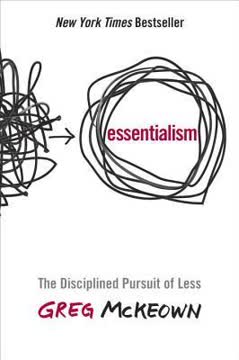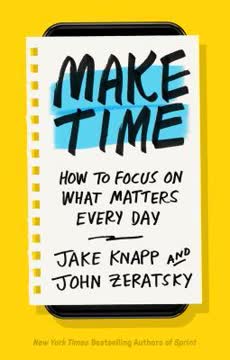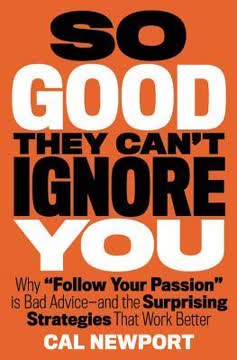Key Takeaways
1. Digital minimalism: Use technology intentionally to support your values
Digital minimalists see new technologies as tools to be used to support things they deeply value—not as sources of value themselves.
Intentional tech use. Digital minimalism is a philosophy that helps people be more intentional about their technology use. It involves identifying your core values and only adopting technologies that directly support those values. This approach contrasts with the common maximalist mindset of adopting any technology that offers some potential benefit.
Benefits of minimalism:
- Reduces information overload and digital clutter
- Increases focus on meaningful activities
- Improves overall life satisfaction
- Allows you to take advantage of technology's benefits while avoiding its pitfalls
Digital minimalists are comfortable missing out on the latest trends or apps if they don't align with their priorities. They focus on optimizing their use of a small number of carefully selected digital tools rather than trying to keep up with every new technology.
2. The attention economy exploits psychological vulnerabilities
The key issue is that using social media tends to take people away from the real-world socializing that's massively more valuable.
Engineered addiction. Many popular digital services are designed to be addictive, exploiting psychological vulnerabilities to keep users engaged for as long as possible. This "attention economy" business model relies on maximizing user screen time to generate advertising revenue.
Common manipulation tactics:
- Variable reward schedules (like slot machines)
- Social validation feedback loops (likes, comments)
- Endless scrolling and autoplay features
- Push notifications and red notification badges
These techniques hijack our brain's reward systems, leading to compulsive checking and usage. The result is that many people spend far more time on these platforms than they intend or find valuable. Understanding these manipulative design practices is crucial for regaining control over our attention and time.
3. Solitude deprivation harms mental health and well-being
We're left, then, with a technology that's required in your social life while simultaneously reducing the value you derive from it.
Constant connectivity costs. The ubiquity of smartphones and social media has led to a state of "solitude deprivation" for many people. This lack of time alone with our thoughts can have serious negative impacts on mental health and well-being.
Benefits of solitude:
- Emotional regulation
- Self-reflection and personal growth
- Problem-solving and creativity
- Strengthening relationships (paradoxically)
Historical figures like Lincoln and Thoreau recognized the importance of solitude. Modern research shows that young people who have grown up with constant connectivity are experiencing higher rates of anxiety and depression. It's crucial to create space for solitude in our lives, even in a hyper-connected world.
4. High-quality leisure activities are crucial for a fulfilling life
Doing nothing is overrated.
Active leisure. Engaging in high-quality leisure activities is essential for a fulfilling life. These pursuits should be intentional, often requiring effort and skill development, rather than passive consumption of low-quality entertainment.
Characteristics of high-quality leisure:
- Requires effort and skill development
- Provides a sense of accomplishment
- Often involves creating something tangible
- Can be social and community-oriented
Examples include learning a musical instrument, woodworking, gardening, or participating in sports leagues. These activities provide more lasting satisfaction than scrolling through social media or binge-watching TV shows. Prioritizing such pursuits can help fill the void left by reducing digital distractions.
5. Reclaim real-world social connections from digital substitutes
Face-to-face conversation unfolds slowly. It teaches patience. We attend to tone and nuance.
Quality over quantity. While digital communication tools promise to keep us more connected, they often lead to lower-quality interactions that can't replace the richness of face-to-face conversations. Reclaiming real-world social connections is crucial for maintaining meaningful relationships and overall well-being.
Strategies for better connections:
- Prioritize in-person meetings over digital communication
- Use digital tools to facilitate real-world gatherings, not replace them
- Practice conversation skills and active listening
- Join clubs or groups that meet regularly in person
By shifting focus from maintaining many shallow online connections to nurturing fewer, deeper relationships, we can experience more fulfilling social lives. This may mean being less available for constant digital communication but more present for meaningful interactions.
6. Implement a 30-day digital declutter to reset your relationship with technology
To succeed with digital minimalism, you have to confront this rebalancing between conversation and connection in a way that makes sense to you.
Reset and rebuild. A 30-day digital declutter is an effective way to reset your relationship with technology and build new, intentional habits. This process involves taking a break from optional technologies and then reintroducing them selectively based on their alignment with your values.
Digital declutter process:
- Define which technologies are optional for you
- Take a 30-day break from these optional technologies
- Explore alternative activities during the break
- Reintroduce technologies selectively, with clear rules for use
This declutter period allows you to break addictive habits and gain perspective on which digital tools truly add value to your life. It also provides an opportunity to rediscover offline activities and social connections that may have been neglected.
7. Join the "attention resistance" movement to regain autonomy
To approach attention economy services with the intentionality proposed by Ginsberg and Burke is not a commonsense adjustment to your digital habits, but is instead better understood as a bold act of resistance.
Reclaim your attention. The "attention resistance" movement aims to help individuals regain control over their time and attention in the face of increasingly sophisticated attempts to capture and monetize these resources. This involves adopting specific strategies to use digital services on your own terms.
Attention resistance tactics:
- Remove social media apps from your phone
- Use website blockers to limit access to distracting sites
- Set specific times for checking email and social media
- Opt for "dumb" phones or limited-function devices when possible
By treating engagement with attention economy services as a deliberate choice rather than a default state, you can extract value from these tools without falling victim to their addictive design. This resistance requires ongoing effort but leads to greater autonomy and intentionality in digital life.
8. Embrace "slow media" consumption for better information processing
Breaking news is almost always much lower quality than the reporting that's possible once an event has occurred and journalists have had time to process it.
Quality over speed. The "slow media" approach emphasizes consuming news and information in a more deliberate, less reactive manner. This contrasts with the constant stream of breaking news and social media updates that can lead to information overload and anxiety.
Slow media principles:
- Focus on high-quality, in-depth sources
- Limit consumption to specific times rather than constant checking
- Seek out diverse viewpoints on important issues
- Allow time for reflection and processing between information intake
By adopting these practices, you can stay informed without being overwhelmed or manipulated by the rapid-fire nature of modern media. This approach leads to better understanding and retention of important information, as well as reduced stress and anxiety related to news consumption.
9. Dumb down your smartphone to reduce compulsive checking
Declaring freedom from your smartphone is probably the most serious step you can take toward embracing the attention resistance.
Simplify for focus. "Dumbing down" your smartphone by removing addictive apps and features can significantly reduce compulsive checking and increase focus. This approach recognizes that smartphones, while useful, often serve as Trojan horses for the attention economy.
Strategies for dumbing down:
- Remove social media and news apps
- Disable push notifications for non-essential apps
- Use grayscale mode to reduce visual appeal
- Consider switching to a "dumb" phone for calls and texts only
While this may seem extreme, many who have tried it report feeling less anxious and more present in their daily lives. The key is to transform your smartphone from an always-on portal to the digital world into a tool that you use intentionally for specific purposes.
Last updated:
FAQ
What's "Digital Minimalism: Choosing a Focused Life in a Noisy World" about?
- Philosophy of Intentional Use: "Digital Minimalism" by Cal Newport advocates for using technology intentionally to enhance life rather than detract from it.
- Focus on Values: The book emphasizes focusing online time on a small number of carefully selected activities that support your values.
- Reclaiming Attention: It argues against mindless adoption of digital tools and stresses reclaiming attention from the digital attention economy.
Why should I read "Digital Minimalism"?
- Regain Control: The book offers insights into regaining control over your digital life by reducing time spent on low-value activities.
- Improve Well-being: Newport discusses how excessive technology use negatively impacts mental health and well-being, offering strategies to counteract this.
- Actionable Strategies: It provides practical advice and real-life examples to help implement digital minimalism effectively.
What is the "Digital Declutter" process in "Digital Minimalism"?
- 30-Day Break: The process involves a 30-day break from optional technologies to reset digital habits and gain clarity.
- Rediscover Meaningful Activities: During this period, you explore activities that bring satisfaction and meaning to your life.
- Selective Reintroduction: After the break, reintroduce only technologies that serve your deeply held values, using them intentionally.
What are the key takeaways of "Digital Minimalism"?
- Intentional Technology Use: Focus on tools that provide significant value and eliminate those that do not.
- Digital Declutter: A structured process to reset your relationship with technology and identify essentials.
- High-Quality Leisure: Replace low-value digital distractions with activities that offer deeper satisfaction and fulfillment.
How does "Digital Minimalism" suggest handling social media?
- Intentional Use: Use social media only if it supports something you deeply value, avoiding mindless scrolling.
- Set Procedures: Establish strict rules for when and how you use these platforms to maximize benefits.
- Prioritize Real Interactions: Emphasize real-world interactions over digital connections for more substantial social fulfillment.
What is the role of solitude in "Digital Minimalism"?
- Crucial for Reflection: Solitude is essential for self-reflection, emotional balance, and generating new ideas.
- Combat Solitude Deprivation: Constant connectivity leads to anxiety and lack of clarity; solitude helps counteract this.
- Practical Practices: Newport suggests practices like leaving your phone at home and taking long walks to cultivate solitude.
How does "Digital Minimalism" address technology addiction?
- Designed to be Addictive: Many digital tools use psychological hooks like intermittent reinforcement to keep users engaged.
- Understanding Mechanisms: Recognizing these mechanisms helps resist compulsive use and regain autonomy over attention.
- Breaking Free: The book provides strategies to break free from addictive patterns and focus on meaningful activities.
What are some practical steps to implement digital minimalism according to Cal Newport?
- Conduct a Digital Declutter: Start with a 30-day break from optional technologies to reset habits.
- Set Clear Rules: Establish clear rules for technology use to align with your values and goals.
- Engage in High-Quality Leisure: Replace mindless digital consumption with activities that require skill and effort.
What is the conversation-centric communication philosophy in "Digital Minimalism"?
- Focus on Real Conversations: Prioritizes real conversation over digital connection, emphasizing analog cues like tone and expressions.
- Supportive Digital Connection: Digital tools should support arranging conversations, not replace them.
- Deeper Interactions: Reduces digital interactions to focus on deeper, more meaningful relationships.
How does "Digital Minimalism" address the attention economy?
- Attention Economy Explained: Describes a business model that profits from capturing consumer attention through digital distractions.
- Resistance Movement: Introduces an attention resistance movement to extract value from digital services without falling into traps.
- Strategies for Resistance: Offers strategies like deleting social media apps and using tools to block distractions.
What are some memorable quotes from "Digital Minimalism" and their meanings?
- "The cost of a thing...": Highlights that time and attention are valuable resources not to be wasted on low-value activities.
- "We didn’t sign up...": Emphasizes the unintended consequences of current digital habits and the need for intentional change.
- "Digital minimalists see new technologies...": Encapsulates the core philosophy of using technology to support deeply held values.
How does "Digital Minimalism" suggest handling social media like a professional?
- Curated Use: Focus on extracting value rather than mindlessly scrolling for entertainment.
- Selective Engagement: Follow high-quality accounts and use tools to filter out noise for intentional use.
- Time Management: Limit use to specific times and durations to prevent constant distraction and focus on meaningful activities.
Review Summary
Digital Minimalism receives mixed reviews, with many praising its practical advice on reducing technology use and reclaiming focus. Readers appreciate Newport's balanced approach, acknowledging technology's benefits while critiquing its addictive nature. Some find the book life-changing, implementing digital detoxes and reevaluating their relationship with social media. Critics argue it lacks nuance, overlooks certain demographics, and doesn't fully address modern work realities. The writing style and structure receive both praise and criticism. Overall, most readers find value in the book's core message of intentional technology use.
Similar Books









Download PDF
Download EPUB
.epub digital book format is ideal for reading ebooks on phones, tablets, and e-readers.












